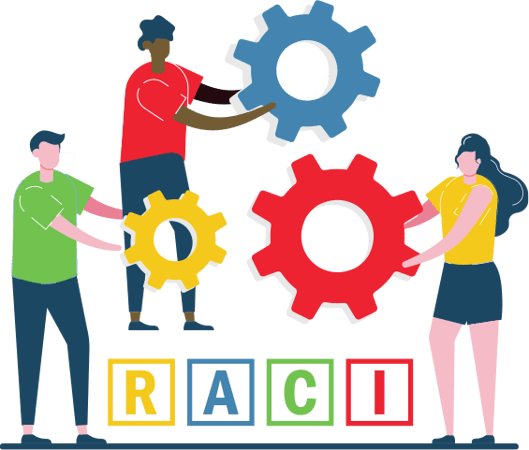
The four RACI codes (Responsible, Authorize, Consult and Inform) are easy enough to understand. Probably the best web download on the subject is on the Project Management Institute website by Michael L. Smith and James Erwin.
Let’s start by looking at the basic building blocks of RACI, the codes:
|
Responsible “R” |
The individual(s) who actually completes the task, the action/implementation. Responsibility can be shared. |
|
R-Prime "R1" |
We add an R-Prime code to RACI whenever two or more people are collaborating. This role orchestrates and understands the work that other "R" individuals are doing. |
|
Authorize “A” |
The individual who is making the decisions. Includes yes or no authority and veto power. |
|
Consult “C” |
The individual(s)or groups to be consulted prior to a final decision or action. |
|
Inform “I” |
The individual(s) or groups who need to be informed after a decision or action is taken. |
RACI is really a tool. Like many tools, although it is simple, the RACI model starts to feel more complex as soon as you put it into practice. In this way, working with RACI is more like a SKILL that needs to be developed than it is like a LEARNING that you acquire by reading or hearing a presentation about it. Think for a moment about learning to play a musical instrument, like the violin. You can understand the theory behind violin sound production, you can listen attentively while someone demonstrates the beautiful sounds that a violin can make, but until you take the violin into your own hands and try to play it, you will always remain in the audience. Anyone who has tried to play a violin will attest to the fact that it is a lot harder to make beautiful music with it than it looks!
So let’s see if we can get underneath the simple definitions of the RACI codes and understand how they really operate in practice.
Responsibility: The “R” code is important when you are trying to enhance ACCOUNTABILITY in the system. The person who holds the “R” is the one who will make sure that this piece of work gets done. If you have an “R” for a piece of work, you are asking yourself questions like, “When will I have time to do this work? What kinds of resources will it take? When is it due?” The anxiety of holding the "R" role is whether or not you can do everything, or do everything well. If you have too many "R"s, you feel overwhelmed.
If the work doesn’t get done at all, that’s a failure of the "R" accountability in the organization.
R-Prime: The R-Prime or "R-1" code is used whenever two or more people have "R" responsibility for a shared task. This kind of collaboration is great, but it can also create confusion about who is doing what or duplication of work. The R-Prime role takes responsibility for orchestrating the work of the others. This individual may have work on their own to contribute or they may just be the coordinator. In either case, you always know you can ask the R-Prime individual to update you on the status of that activity.
Authorize: The “A” role holds the AUTHORITY in the system, and must approve a decision or determine if a particular task has been done well. This person is accountable for something quite different—their job is to exercise judgment in making the decision. If you have the "A" role for a piece of work, you are making a choice. The risk for you in the "A" role is simple but profound: you can be wrong.
Note that we define the "A" differently than the Project Management Institute, who defines the "A" as Accountable. At RACI Solutions, we believe that all the roles have accountability built into them, and so we define the "A" as Authorize. In our system, the person with the "A" role has the authority to make decisions or exercise a veto. Anyone who can stop a project from moving forward is the "A".
So what if you delegate work to someone else, and give him or her the "R"? Being in the "A" role often means that you are the person who must ultimately supervise them in doing that work. Did the job get done? Did the job get done well enough? These are the kinds of things you worry about.
Consult: The “C” role is perhaps the easiest to understand. A person is given a “C” role if they have a particular knowledge or expertise to CONTRIBUTE to the decision or the task. In this role, you give advice. It’s easy to recognize a “C” role because if you have a "C," you must be included BEFORE the decision is made. People turn to you because they believe that you know something important that will contribute to a good recommendation or outcome.
Think about IT and new product design—often we give the "C" role to a group of end users so that they can improve the design before it is finalized. (This is an old socio-technical principle that those who use a product should participate in its design.)
Inform: The “I” role comes after the fact, because the person doesn’t participate in the decision before it is made. In the "I" role, you are INFORMED about the decision afterwards—you don’t participate. Thinking carefully about who “needs to know” about actions and decisions is good stakeholder management.
You can use these four RACI codes as a language—a kind of shorthand—to talk about accountability and authority in your workplace, without ever taking the next step of constructing a formal RACI matrix. This way of using RACI—call it RACI Lite—is powerful all by itself and will enhance collaboration tremendously—all you have to do is know what you’re talking about.
About RACI Solutions
RACI Solutions has been helping organizations across the globe utilize the power of RACI to transform the dynamic of cross-functional teams since 2007. Whether you are new to RACI or have used it for years, we can help.
Today’s business environment is complex – you may be contending with matrix structures, rapid growth, mergers, multiple locations, virtual employees, and/or digital transformation.
As a result, project teams can get stuck. Let us help you! If you need to learn RACI, we offer train-the-trainer materials and custom workshops. We can help you create RACI super-users. If you already use RACI or another decision matrix, we offer programs that help you become skilled at working across functions – an effective horizontal leader. We help project teams tune up their performance. We help organizations streamline their decision-making.
Our team is comprised of expert consultants, trainers, and facilitators, who can help your teams and their leaders achieve a seamless level of collaboration.





